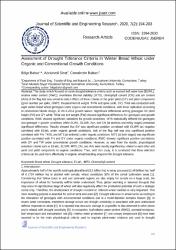Assessment of Drought Tolerance Criteria in Winter Bread Wheat under Organic and Conventional Growth Conditions

Göster/
Erişim
info:eu-repo/semantics/openAccessTarih
2020Erişim
info:eu-repo/semantics/openAccessÜst veri
Tüm öğe kaydını gösterKünye
Bahar, B., Sirat, A., Baltacı, C., 2020. Assessment of Drought Tolerance Criteria in Winter Bread Wheat under Organic and Conventional Growth Conditions. Journal of Scientific and Engineering Research, 7 (2), 194-203, April 2020.Özet
This study which focused on some drought tolerance criteria such as excised leaf water loss (ELWL), relative water content (RWC), membrane thermal stability (MTS), chlorophyll content (Chl) and ash content (Ash) of the flag leaf was aimed to detect effects of these criteria on the grain yield (GY) and yield components (grain number per spike, GNPS; thousand kernel weight, TKW and spike yield, SY). Trial was conducted with eight winter bread wheat genotypes under organic and conventional conditions, with three replication according to randomized blocks design, in 2013-2014 growth season. Significant differences among genotypes for plant height (PH) and GY while TKW and test weight (TW) showed significant differences for genotypes and growth conditions. RWC showed significant variations for growth conditions. MTS statistically differed for genotypes and genotype × growth conditions while ELWL, ELWR, Ash, and Chl (at anthesis and milky stages) presented significant differences. Results showed that GY was significant positive correlated with ELWR but negative correlated with ELWL under organic growth conditions. Ash of the flag leaf was also significant positive correlated with PH, TKW, and MTS (at anthesis) under organic conditions. MTS (at both stages) was significant positive correlated with PH and GY under organic conditions. RWC showed significant positive correlations with GY and TW under conventional growth conditions. However, as seen from the results, physiological selection criteria such as ELWL, ELWR, MTS, Chl, and Ash were mostly significantly related to each other and yield and yield components in organic conditions. Thus, with this study, it is concluded that these selection criteria can be used more effectively in organic wheat breeding programs for drought tolerance.

















